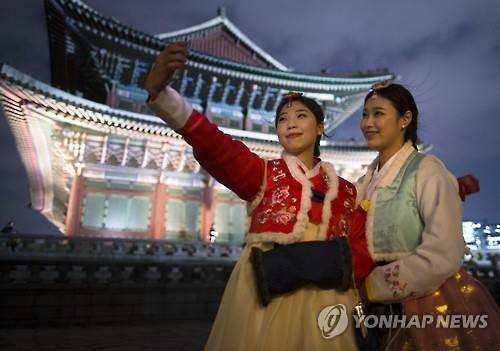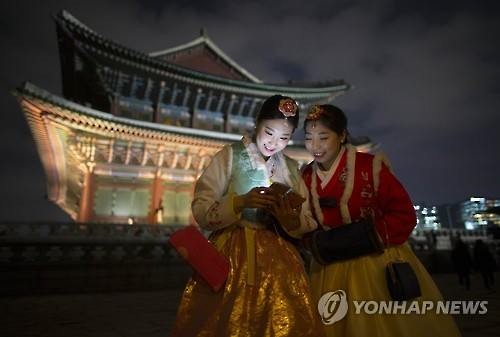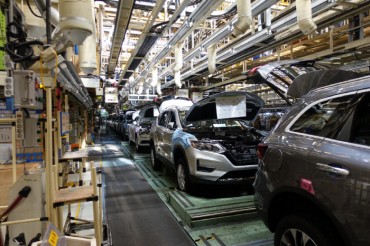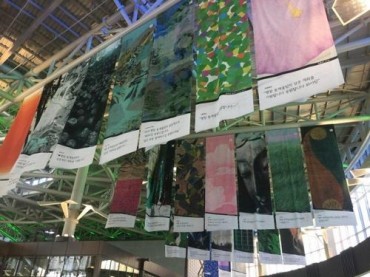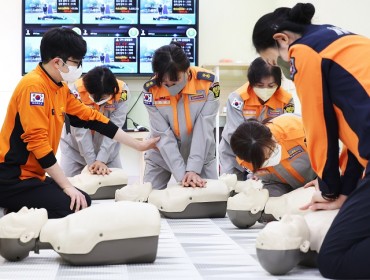SEOUL, March 23 (Yonhap) – Normally, a 100-person-deep queue in front of Gyeongbok Palace in Seoul would hardly raise any eyebrows. After all, it’s the most iconic attraction in the city.
In a wintry March evening, though, it very well may have — not only because palaces are often closed after dark, but because these people had braved sub-zero temperatures to come here from as far as Abu Dhabi.
To be sure, palace visits after sunset aren’t news. South Korea has allowed them for limited periods of time since its capital city Seoul hosted the G20 Summit in 2010.
What started as an offbeat national PR event, however, has rapidly turned into an annual tradition, and the popular demand from both South Koreans and foreigners has upgraded its scale and duration every year, said Kim Tae-woo, an official at the Royal Palaces and Tombs Division of the Cultural Heritage Administration (CHA).’
“We decided to make these late-night palace viewings annual in 2011 to promote the cultural and historic values of our palaces and to make better use of our cultural assets,” Kim told Yonhap News Agency by phone. “We also wanted to provide fellow Koreans with more chances to learn about our cultural heritage.”
Started biannually, these late-night openings at Gyeongbok, Changdeok and Changgyeong Palaces, all in Seoul, were expanded to four times a year in 2014.
That still wasn’t enough to meet demand — there were 185,000 of visitors last year, even though there could have been more, because the CHA caps the number of admissions to 2,500 a day. It’s why viewings will take place over the course of 120 days this year, up drastically from the previous 48.
Kim Cho-rong, who was among a few dozen people wearing “hanbok,” the Korean traditional dress, that evening, said she and her boyfriend risked the cold because they’d reserved tickets a week in advance.
“I even bought this hanbok for today,” said Kim, the pastel green of her dress spilling down from beneath her Western-style jacket, which she said she wouldn’t have layered had the day been nicer.
Even this year, the first batch of tickets for March 1 to April 4 were sold out in less than two hours, Kim, the CHA official, said. But those who failed to reserve a spot could still purchase one directly from the palaces, which allow 150 additional guests per day.’
Kim and her boyfriend were by no means the only selfie-obsessed couple among the crowd at Gyeongbok. In fact, many, if not most, visitors were busy taking their self-portraits against the palatial backdrop.
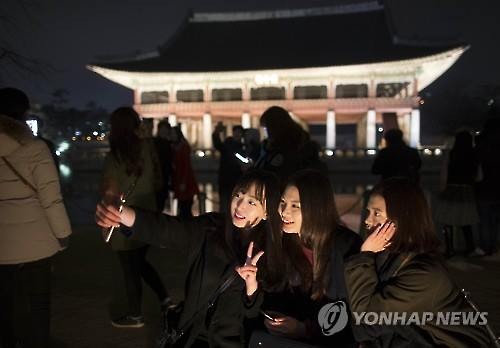
Visitors pose for selfies in front of the Gyeonghoeru Pavilion inside Gyeongbok Palace in Seoul on March 2, 2016. (Image : Yonhap)
A couple of 20-something Korean women dressed in hanbok were in a foul mood after their photoshoot went awry.
“We’re upset because our tripod is broken,” one of them said, asking not to be questioned further.
Many of them had brought a selfie stick and were searching for the best photo spots. Occasionally, they would pause at the entrance of an ancient hall to observe the glowing interior before taking more photos in front of it.
Now six years running, the annual event has cultivated a faithful following.
Kim Yong-su, a retiree from Uijeongbu, north of Seoul, had visited Gyeongbok Palace this time of day and year since 2013. Even though he’d taken photos of this royal residence at night, the self-proclaimed amateur photographer said he liked to update his portfolio every year to see progress.
“The lighting at night also makes for greater photos than those taken in the day,” the 63-year-old said, bent over a tripod, with his DSLR camera aimed at the Geunjeongjeon Hall.
A Japanese couple said even though they’d visited the palace during the day they wanted to see what it was like at night.
“We heard about these late-night openings on the Japanese news,” Eiji Sasaki, who called himself an avid Korea fan, said. The couple had just arrived here for a three-day trip, their fifth one.’
The Sasakis weren’t the only foreign couples who had come straight from Incheon International Airport, South Korea’s main gateway west of Seoul, that evening.
Alice Lenihan, originally from Italy, said she and her boyfriend, Cesare Torrieri, had arrived from Abu Dhabi for a weekend trip earlier that day. The owner of their hostel had recommended that they take an evening stroll among this Joseon Dynasty (1392-1910) architecture.
“It’s a beautiful palace,” Lenihan said. “Unfortunately, we don’t know much about it because there were no guides, but we’ll go look at some books at the souvenir shop.”
Lenihan said she’d wanted to come to Seoul since childhood after watching the Japanese cartoon “Attack No. 1″ set in the 1988 Seoul Olympics.
“Since then, Seoul has been stuck in my mind,” the 32-year-old flight attendant said, followed by a giggle.
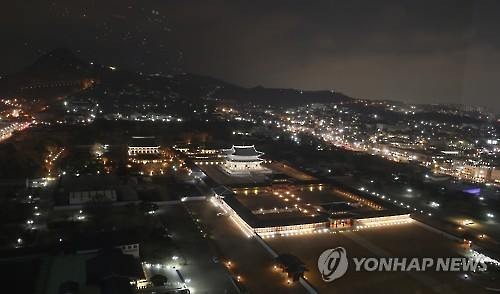
An aerial view of Gyeongbok Palace in Seoul, which is open from 7-10 p.m. from March 1 to April 4, 2016. (Image : Yonhap)
Only 40 percent of Gyeongbok Palace is revealed at night, with visitors accepted from 5 to 9 p.m. Viewings may last until 10 p.m.
This year, the parts made public at night have been expanded to include three other halls — Gangnyeongjeon, Gyotaejeon and Sajeonjeon. Previously, only two of the most popular sites, the Gyeonghoeru Pavilion and the Geunjeongjeon Hall, were open to the public.
The CHA has also increased the number of Moonlight Tours offered at Changgeong Palace from 35 to 50 this year.
The second set of late-night viewings will run from April 29 to June 1.’
(Yonhap)


